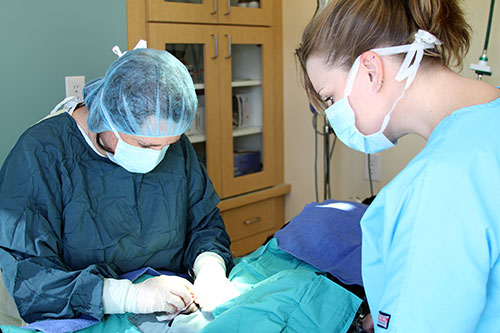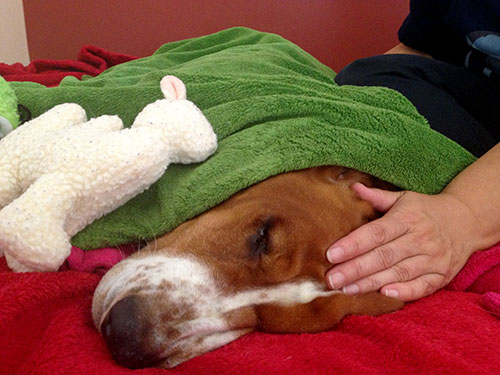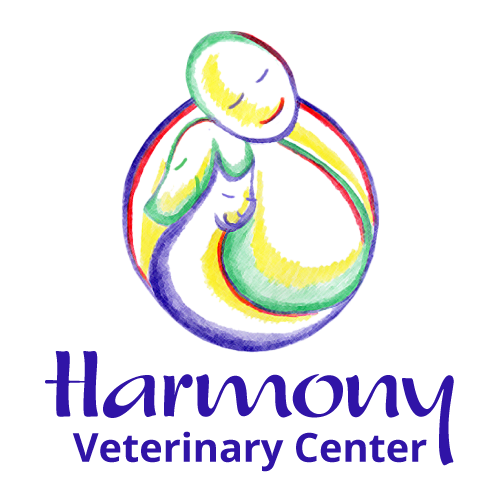
Nearly all pet owners worry about anesthesia in their pets. Although anesthesia can never be risk free, most animals from the very young to the very old can be anesthetized safely. And often, not performing a necessary anesthetic procedure can be more detrimental to your pet’s health than undergoing the surgery.
Rest assured that at Harmony Veterinary Center, our highly trained staff adheres to the highest standards of anesthetic monitoring and surgical care. Modern EKG, pulse oximetry, and blood pressure equipment allow us to monitor your pet’s vital functions during surgery, which means the most accurate and safest possible administration of anesthesia for your dog or cat.
What Safety Measures Do We Take?
Before Surgery:
Prior to any anesthetic procedure, we perform a thorough physical exam on your pet to assess heart and lung function, blood circulation, organ function, and overall health. While this exam is helpful it doesn’t always tell the whole story, so we require pre-anesthetic blood tests be performed on all pets to determine baseline liver and kidney functions and to assist our veterinarians and certified veterinary technicians in safely administering anesthesia to your pet.
Then we determine the following, as the answers also influence the proper choice and administration of the anesthesia:
- Can we safely perform the surgery with little or no anesthesia?
- Is this breed sensitive to any anesthetic drugs?
- Is this animal young, adult, or senior?
- Is this surgery a long or a short procedure?
- Will radiographs be necessary prior to or during anesthesia?
- Are pre or post-surgical supportive therapies or supplements necessary?
- How painful is the surgery and how can this pain be minimized?
- What recovery methods might assist and ease the pet’s recovery?
- Does the pet have any complicating medical conditions, such as seizures or chronic diseases?
- Are there any other special considerations?
During Surgery:

Our certified veterinary technicians continuously monitor heart and lung function, blood pressure, oxygen levels in the blood, body temperature, and anesthetic depth to make sure the entire anesthetic procedure goes smoothly. Pets are placed on heated surgical tables and circulating warm water blankets to help maintain body temperature. Intravenous fluids are administered throughout the anesthesia to maintain blood pressure and hydration, and to help the patient process the anesthetic drugs, which leads to a quicker recovery. Each patient has an individualized emergency drug sheet that lists the appropriate amount of any emergency drug that may be needed, saving valuable time should an emergency occur. With the IV catheter in place, emergency drugs can be delivered immediately.
After Surgery:
A recovery team member will sit with your pet, or hold them, while utilizing Medical Qigong (energy therapy) to ease any fear or confusion your pet may feel when waking up from anesthesia. Warm blankets and pads are placed on your pet to aid in supporting their body temperature. Soft lighting is utilized as much as possible to ease their transition from anesthesia to being fully awake. Our goal is to make this as pleasant and comforting an experience as possible for each pet coming out of anesthesia.

We carefully supervise and control recovery, monitoring the following until your pet is released into your care:
- Respiration (Breathing)
- Temperature
- Comfort levels
- Need for pain medication
- Need for complementary therapies
After your pet is awake he or she will be exercised and provided a small meal and small amounts of water. It is only when a pet is fully recovered from anesthesia and able to walk on his or her own that we allow the pet to return home to your care.
When your pet is released into your care, you will receive written instructions for home care, including exercise and feeding recommendations, medication instructions, necessary follow-up appointments, and other information on your pet’s condition. The doctor or a certified technician will go over these with you and answer any questions you may have. We will call the next day to make sure your pet is recovering well and urge you to call us with any concerns.
At Harmony Veterinary Center, our goal is to make the anesthesia process as easy as possible on both and your pet.
